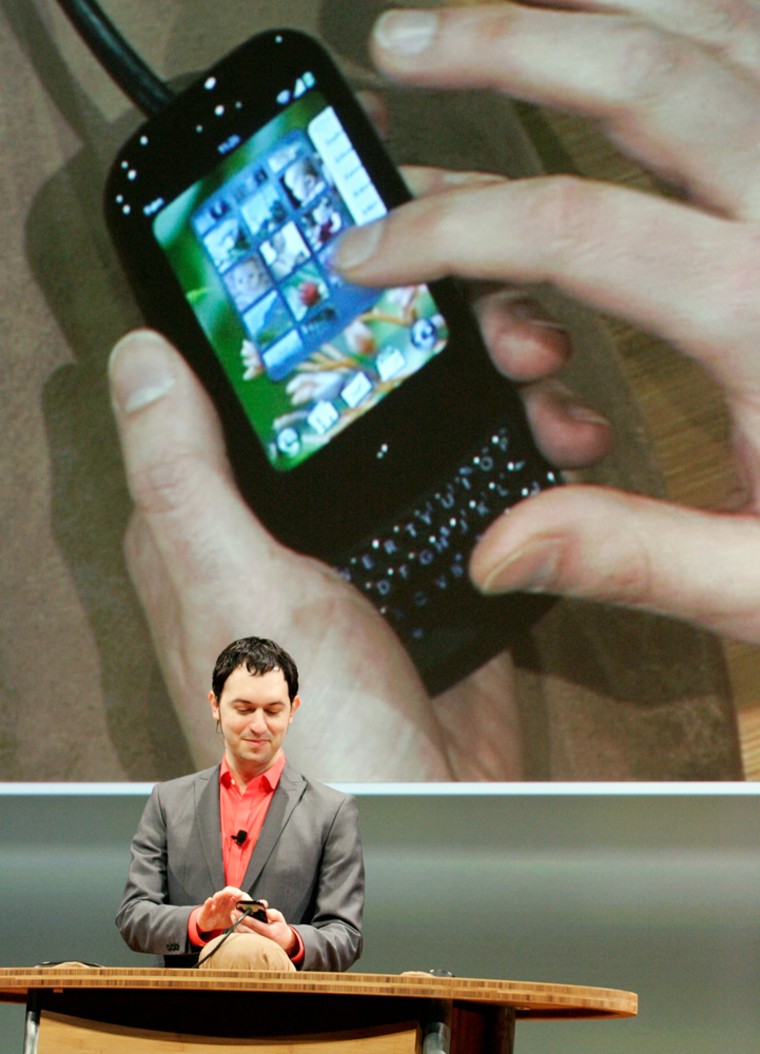Palm Thursday unveiled the "Pre" smartphone, more similar to an iPhone than a Treo in looks, and a new operating system called Palm webOS, with hopes that both will keep the venerable but struggling company in the smartphone race.
The Pre — rhymes with "tree" — has a 3.1-inch touchscreen but also comes with a slide-out physical QWERTY keyboard.
Palm executive chairman Jon Rubinstein unveiled the device, which will be carried by Sprint, at the International Consumer Electronics Show in Las Vegas. It should be available the first half of this year, and no price has been set yet.
The 4.76-ounce Pre will have Wi-Fi, GPS, a 3-megapixel camera and include an accelerometer — a motion sensor used to change the screen from portrait to landscape mode — useful for Web surfing, e-mail and videos. The device will come with 8 gigabytes of internal storage.
The new operating system will include “Palm Synergy,” a feature that should be extremely popular. It will give users one view of their contacts from many different sources, including Outlook and other e-mail accounts, as well as from social networking site Facebook. The operating system also lets users “multitask,” do more than one thing at one time, by keeping more than one program open at a time, something Palm’s previous OS did not do.
Palm's Treo, still on the market, was in many ways the granddaddy of consumer smartphones, and once dominated the market for those who wanted more than a basic cell phone. The Treo offered not only comprehensive calendar and contacts programs, thanks to its successful PalmPilot roots, but also Internet access and e-mail.
Now, with a smartphone market starting to get crowded and dominated by Research In Motion's more lifestyle-oriented BlackBerrys and Apple's iPhone, Palm's devices, including Centros, have been eclipsed, even "hit hard," says Paul Carton, director of research for ChangeWave Research.
In June 2006, Palm had 36 percent, and RIM, 30 percent of the smartphone market in the United States, according to ChangeWave. By January 2007, those numbers had pretty much flipped around. RIM led with 37 percent, and Palm had 30 percent, with other brands, such as Motorola and Samsung, making up the difference.
That was before the iPhone launched in mid-2007 and went on to become the No. 2-selling smartphone brand in the country. As of December, RIM had 41 percent, Apple 23 percent and Palm 9 percent of the U.S. smartphone market, ChangeWave says.
Palm, headed by Apple alum Rubinstein, has been as secretive as Rubinstein's former employer about what's in the works for the company's new products.
A hint may have come from Ed Colligan, the company's CEO, who said in a that "People's work and personal lives are melding," and that Palm wants to appeal to the "fat middle of the market."
On its Web site, Palm telegraphed its intentions with four words: "Really smart. Super simple."
The new operating system, called simply "Palm webOS," and previously dubbed Nova, lets users "multi-task," or use several programs at once, something previous Palm devices could not do.
The new operating system "seems to be Palm's last-ditch efforts in this space," said Kevin Burden ABI Research's mobile devices research director in a recent interview.
Palm has used its own operating system, as well as Windows Mobile, in its Treos, often giving users a choice of which operating system they prefer. The company's Centros run on the Palm OS, with the current version more than five years old. (Msnbc.com is a joint venture of Microsoft and NBC Universal.)
Many Treo users have opted for the Palm OS' icon-friendly screens and menus to those of Windows Mobile.
Certainly, of those migrating to the iPhone from other devices, a good number of them are former Treo users who found Apple's device to be a souped-up, snazzier and even easier-to-use version of the Treo.
Palm has lagged behind in bringing improvements to its operating system. Web-browsing on a Palm, once revolutionary, has been slow and kludgy compared to phones like the BlackBerry, iPhone or G1. The Palm's music player has been barely basic. However, in contrast to the iPhone, the Palm has had a copy-and-paste function, and can also take video.
"One of Palm's best qualities is its simplicity and its personal information management applications," said Avi Greengart, Current Analysis' research director for mobile devices, recently. "The Palm OS is still the easiest operating system to add a calendar appointment to."
Apple's App Store, part of its online iTunes Store, has been a huge success, letting iPhone users easily download programs, some free, some paid. The Android Market is also in business, and RIM plans an "application storefront" in March.
Palm, too, is trying to improve and update its offerings. One obvious way to do so would be allowing direct downloads to Palm phones, instead of having to use the computer as an intermediary, then syncing the phone with the computer.
Palm began selling software online to customers in the 1990s, "and there are still more apps for that platform than any other," said Greengart.
Palm spokeswoman Leslie Letts said recently there are "tens of thousands" of software programs for Palm-based devices.
Software developers "understand and appreciate our loyal customer base, and are eager to work with Palm," said Letts.
